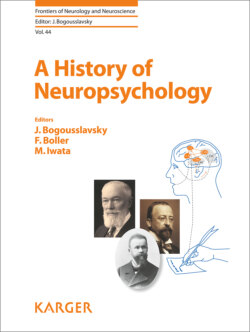Читать книгу A History of Neuropsychology - Группа авторов - Страница 25
На сайте Литреса книга снята с продажи.
Explanations of Hemispheric Specialization
ОглавлениеHow could cerebral specialization be explained? For Broca [20], the challenge was significant because, in declaring that we speak with the left hemisphere, he noted that, except for certain “secondary convolutions,” the hemispheres were “perfectly alike” (p 381). (Malgaigne [10], we recall, saw things differently.) How, then, could asymmetrical control for speech be reconciled with the “general truths [the law of symmetry] it seems to contradict” (pp 381–382)?
Broca saw a clue in something Leurat and Gratiolet [48] found in the brains of human fetuses: frontal convolutions appear earlier on the left. Could that dispose the left hemisphere to take the lead in complex acts like speech and language? Further reports, however, were mixed, some finding earlier development on the left (e.g., [49], others on the right, e.g., [50], and still others, no differences [51]). The discrepancies were never resolved. As the author of one of the reports later remarked, “the question which side is first developed seems still doubtful” ([52], p 293).
Could the difference instead lie in the number of convolutions? In the adult brain, Broca, in an apparent change from his prior [20] position, reported finding “notably more” on the left (quoted in Bateman [53], p 380). He also found the left frontal lobe to be heavier ([54]). Asked whether F3 made the difference, he said he was inclined to this view but was reluctant to say more given the difficulty in surgically isolating this structure (reported in [55]).
Size was considered too. Cunningham [56] measured the upward angle of the Sylvian fissure’s posterior ramus in human fetuses. Finding it smaller on the left, he concluded that the region it bounded ventrally, containing the planum temporale, part of what by then was being called Wernicke’s area, was larger on that side. But seeing the same in great apes – animals with no known language – he questioned whether it is “in any way associated with … localization of the active speech centre …” (p 293). He presumably meant “comprehensioncentre.”
What about the right hemisphere? For the temporal and occipital lobes, Gratiolet found earlier convolutional development on the right, the reverse of that for the frontal lobes. For the occipital lobe, Broca reported the same for number: “the right is richer in convolutions” (in [53] but, with his focus on speech, would have had no reason to see it as significant. Hughlings-Jackson [38] had very good reason: “These anatomical facts, I submit, support the view … that the hinder part of the brain on the right side, is the chief seat … in the recognition of objects, places, persons, &c.” (p 70).
